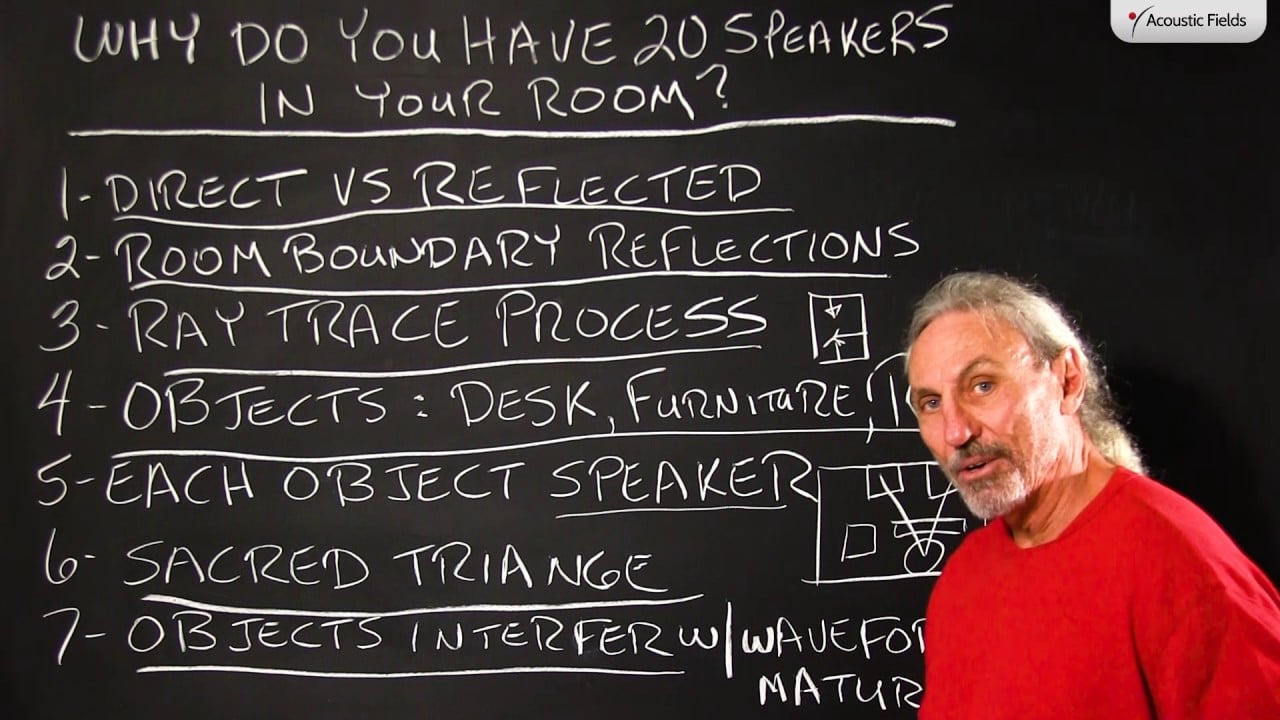Today we’re going to ask the question why do you have 20 speakers in your room and it’s not a home theater room, it’s not Dolby Atmos, a little play on words here but the bottom line is we have to realize that every object in our room is a speaker, it produces reflections, now it’s not active, it’s not a diaphragm moving but energy strikes it and bounces off of it so there’s always a coloration in sound and you can hear this immediately if you put a boundary surface next to your mouth. Objects do that in our room so we always want to keep in mind that our goal is the nice balance between direct versus reflected energy and we’re always going to have reflected energy from our room surfaces. I mean we’re always going to have energy bouncing off the walls and moving around okay.
We have a software program that we use when we manage reflections in rooms, especially in critical listening rooms, control rooms and what this rate trace program does is it takes energy from a source and it bounces it around in the room and it shows us frequency and amplitude and places that are going to cause problems in terms of reflections so we want to be very careful with the objects that we have in our room. And we all know that this sacred triangle here between those speakers in the listening position, this plane you can’t have any objects in it, sacred triangle you could call it, that’s where we got our name for sacred ground in our Hollywood studio.
Each object that you have in the room can turn into a speaker so you have to be very very careful. I see people that will have a desk here, they’ll have a table in front of them here, they’ll have an equipment rack all along one side and nothing on this side and we know that the time signature of those side wall reflections are really important for primary, secondary and tertiary reflections so you have to be careful because objects and the energy that comes off of them from the speakers in the room inhibits the formation of the wave so if it’s a lower frequency wave you’re going to have issues, if its middle and high frequency energy you’re going to have issues and you need distance and space for that energy to mature correctly.
So in this case our direct energy from the speakers are going to strike the desk or whatever it is, the table, it’s going to strike the equipment rack here, produce a whole different series of reflections that we don’t want. It’s hard enough to manage the reflections from a flat surface in your room okay then a surface that has a desk on one side and equipment rack on the other so be very very careful about the objects in your room because they become speakers and then they produce energy that has to be managed and it’s really difficult when you have an unbalanced situation. I mean I’ve had situations where equipment racks are on the left, bookcases are on the right, glass is on the right, equipment racks on the left, doors… you just you have to be very very careful here and just because you can’t see sound you definitely can hear it and each one of those objects in your room produces reflections that can be heard and need to be managed.
—
This is an unedited transcript from our video series from Acoustic Fields. There will be some errors in grammar and sentence structure that occur during this translation process.
For complete understanding and comprehension, please view the video which is included in this text. For any additional information regarding this topic or others relating to room acoustics, please contact us directly at:
P: 520 – 392 – 9486








Hi, I’ve been reading so much about installing studio glass with a slant on the outside, a slant on the inside. And now I’m advised it’s a myth. Your studio glass does not have to have a slant. Is this true? Thanks…
Dale, It depends on the glass position to the monitoring position. It is the angle of the glass that determines the reflection issues at the ears.